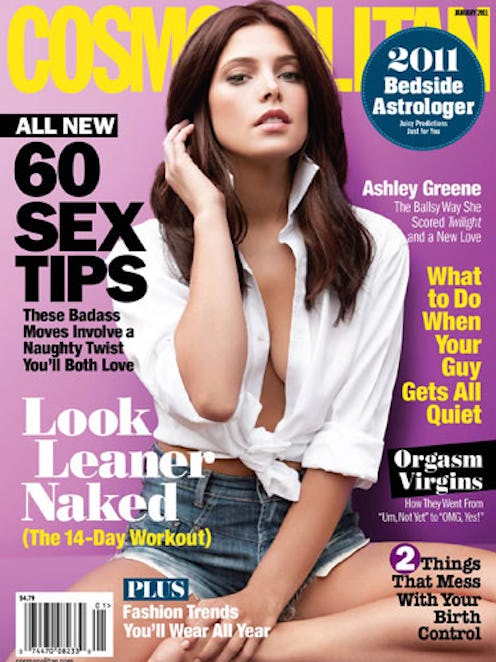
A new rule administered by the National Center on Sexual Exploitation (NCSE) might cause the popular women's magazine Cosmopolitan to to be sold like porn. Yep, that's right — Victoria Hearst, the woman working closely with the NCSE, is likening Cosmo to pornography, and already stores like Rite Aid and Food Lion are planning to start placing the magazine behind blinders as if it were an issue of Playboy. Dawn Hawkins, the executive director of the NCSE told Women's Wear Daily that Cosmo is no more than a porn magazine that glamorizes violent, group, and anal sex and legitimizes dangerous lifestyles. She said, "Articles often encourage readers to engage in one-night stands or random hookups with strangers. The magazine is pornographic and should be treated as such, meaning specifically that it should not be in plain view of children at the checkout line." Hawkins seems particularly concerned about the children this "dangerous" and "pornographic" content will affect.
Hawkins' rationale, and this new status for the magazine, is absurd for a couple of reasons. First, a quick glance at Cosmo' s Media Kit lets us know that about 80 percent of the magazine's readership is between 18 and 49, meaning Cosmo's readers are consenting adults who I'm pretty sure can handle these so-called "dangerous lifestyles" (known in Hawkins' book as one night stands and probably also french kissing). Younger women are seeing the magazine in a checkout line at a grocery store, but an overwhelming number of those consuming it are not underage.
It's also interesting that she has chosen to single out this magazine as a source of pornographic content and not anything else young women see on a daily basis that might constitute as dangerous, violent, or problematic. By that logic, then, why doesn't the NCSE ban sexist Super Bowl ads that are doing nothing but telling women they're objects? Or Robin Thicke and Pharrell's "Blurred Lines" music video? I could go on. Young women are exposed to these images just as frequently and arguably more aggressively than they are exposed to a Cosmo in the checkout lines. Advertisements, television shows, songs, music videos, movies, and various publications are rife with sexually exploitative content, so why is the NCSE going out of its way to focus on a magazine that aims to empower women and not other sources that solely, mercilessly objectify women?
I'm not arguing that Cosmo is perfect, but the publication's diverse content and the positive effect it can have on young women simply cannot be ignored. Some pieces that have come out of the magazine include important information about contraception, discussions about race, positive advice about sex and sexuality, representation of women who are different colors and sizes, and so much more. Though the magazine has a complex history with female empowerment, it has also made tremendous changes within the recent years to better cater to and understand the changing landscape.
When it comes down to it, sexualization and objectification are extremely complicated things that affect girls at every step of their development. But banning a magazine with a variety of positive messages is not the answer and doing it because you think anal sex and casual hookups are dangerous is not a legitimate reason. The problems are much deeper and much more pervasive than Hearst and Hawkins seem to think.
Images: Cosmopolitan